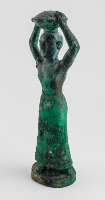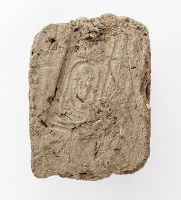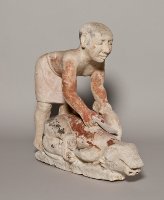Highlights from the Collection: Tools
Foundation Figurine of King Ur-Nammu
King Ur-Nammu rebuilt and enlarged one of the most important temples in ancient Mesopotamia - the E-kur of Enlil, the chief god of the pantheon. This figurine, which was buried in a foundation box beneath one of the temple towers, represents the king at the start of the building project - carrying on his head a basket of clay from which would be made the critically important first brick. The foundation deposit also contained an inscribed stone tablet; beads of frit, stone and gold; chips of various stones; and four ancient date pits found perched atop the basket carried by the king.
Model of a Butcher Shop
A butcher's shop, like the one represented by this model, was part of many large estates in ancient Egypt. On the ground level floor, a trussed bovine is being slaughtered while workmen go about their related tasks. A stairway at the right side of the shop leads to the second floor where two figures stand, cleavers raised, perhaps to receive the meat for carving. Painted wooden models of daily- life activities were commonly placed in Middle Kingdom tombs to serve the deceased in the next life.
Mud Brick Stamped with Cartouche of Ramses II
Although the ancient Egyptians are best known for their stone monuments, they also used mud bricks extensively for building. This brick, which bears the cartouche of Ramses II, was found within the walls of his great mortuary temple, the Ramesseum, along with many reused bricks stamped with the names of his predecessors.
The bricks were made from river mud and straw, shaped in wooden molds and left to dry in the sun; the cartouche or other inscription was stamped on the brick while it was still damp and soft.
The ancient Egyptian word for brick was "debet," a word that has come into our modern vocabulary through the Spanish as "adobe," meaning sun-dried brick.
Potter
Ny-kau-Inpu, a cemetery official who was probably buried in a mastaba in the Old Kingdom cemetery at Giza, included in his tomb a series of statuettes of his family and household servants. By so doing, he hoped to take with him into the afterlife those things that were important to him during his lifetime. This tiny figure of a potter forming a vessel upon a potter's wheel was one of those statuettes, which as a group seem to represent the staff of a typical properous estate owner in Old Kingdom Egypt.
Butcher Slaughtering a Calf
This statuette of a butcher is one of a group of sculptures placed in the tomb of an ancient Egyptian official so that he might take with him into the afterlife things that had been important to him during his lifetime. The group, which seems to represent the household and staff of a typical prosperous estate owner in Old Kingdom Egypt, included representations of the owner Ny-kau-Inpu and his family, two butchers, men and women processing grain and making bread, four musicians, a metalworker with a blowpipe, a potter, and even two children playing leapfrog.






